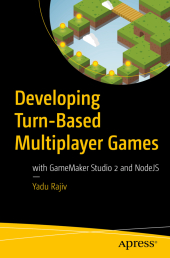 Neuerscheinungen 2018Stand: 2020-02-01 |
Schnellsuche
ISBN/Stichwort/Autor
|
Herderstraße 10
10625 Berlin
Tel.: 030 315 714 16
Fax 030 315 714 14
info@buchspektrum.de |

Yadu Rajiv
Developing Turn-Based Multiplayer Games
with GameMaker Studio 2 and NodeJS
1st ed. 2018. xv, 206 S. 30 SW-Abb. 235 mm
Verlag/Jahr: SPRINGER, BERLIN; APRESS 2018
ISBN: 1-484-23860-5 (1484238605)
Neue ISBN: 978-1-484-23860-8 (9781484238608)
Preis und Lieferzeit: Bitte klicken
Create your first turn-based multiplayer game using GameMaker Studio 2´s built-in networking functions as well as using a simple NodeJS server. This book introduces you to the complexities of network programming and communication, where the focus will be on building the game from the ground up. You will start with a brief introduction to GameMaker Studio 2 and GML coding before diving into the essential principles of game design.
Following this, you will go through an introductory section on NodeJS where you will learn how to create a server and send and receive data from it as well as integrating it with GameMaker Studio. You will then apply multiplayer gaming logic to your server and unlock multiplayer game features such as locating a player, syncing their data, and recording their session.
What You Will Learn
Discover the architecture of GameMaker Studio 2
Add new features to your game with NodeJS modules
Integrate GameMaker Studio 2 with NodeJS
Master GameMaker Studio 2´s built-in networking functions
Who This Book Is For
GameMaker Studio users who want to understand how the networking components of GMS 2 work. Basic JavaScript knowledge is required.
Chapter 1: An introduction to Game Maker Studio 2 Chapter Goal: This chapter helps the reader get started with GMS2, how to download and install it, getting started with a project, an overview of the interface (which will act as a reference later if need be) No of pages: 20
Sub -Topics 1. Downloading and installing GamerMaker Studio 2. Breaking down the interface - where to find what/what does this button do?
Chapter 2: Chapter 2: Introduction to GML Chapter Goal: This chapter serves as an introduction to GML, what is new in GML in GMS2 and how to get started with writing code. This chapter will not be in-depth and will not cover all the functions available in GMS2, but will be a language overview by creating a small game. No of pages: 40
Sub - Topics 1. Writing code in GMS2 - Scripts, Objects and Events 2. Data Types and Variables and Scope 3. Assignments and Expressions 4. Arrays and Data Structures 5. Language Features and Program flow control statements 6. Functions
Chapter 3: Making your first game Chapter Goal: The goal of this chapter is to start on our main game, but a single player version of it. It starts off with a game design process where we plan well in advance what we are going to do; and moves on to talk about how to translate ideas from paper to a prototype. We then move on to build the game from the prototype, adding more complex behaviors and features. No of pages : 70
Sub - Topics: 1. Game Design 101 - a reusable process/framework 2. Planning your game 3. Rooms, Sprites and Objects 4. Building a single player version 5. Getting the core mechanics in place 6. HUDs, Menus and more
Chapter 4: An introduction to NodeJS Chapter Goal: This chapter introduces the reader to NodeJS and how one can get started with it. Some level of JavaScript knowledge is required. We will setup a small server and work with Express. No of pages: 15
Sub - Topics: 1. Installing NodeJS 2. Your first program 3. Extending the server with express
Chapter 5: Talking to your server Chapter Goal: This chapter focuses on integrating our game with our NodeJS server. At first, we will create a feature which reads a list of news updates from the server and display it when the game loads. As a second exercise, we try to read and post a high scores table. No of pages: 40
Sub - Topics: 1. Getting data - A daily news and updates ticker 2. Setting data - A simple high scores page
Chapter 6: Introducing the multiplayer game Chapter Goal: In this chapter, we will implement the game logic on the server - finding a player, starting a game session, playing the game, syncing data etc. No of pages: 50
Sub - Topics: 1. Representing the player and their data 2. Finding a player 3. Playing the game on the server 4. Game session - syncing data across the server and clients


